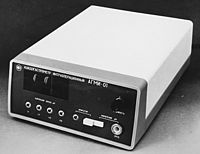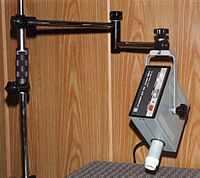- Nikolay Devyatkov
-
Nikolay Dmitrievich Devyatkov Born April 11, 1907
Vologda, Russian EmpireDied February 1, 2001 (aged 93)
MoscowResidence Soviet Union, Russia Citizenship Soviet Union, Russia Nationality Russian Fields Electronics Institutions NPC "Istok"
Institute of Radio-engineering and Electronics
Moscow Institute of Physics and Technology[1]Alma mater Leningrad Politechnical Institute[1] Known for Inventor of a reflex klystron
MM-wave TherapyNotable awards Hero of Socialist Labor (1969), Stalin Prize (1949), Lenin Prize (1965), State Prize of the Russian Federation (2000) Nikolay Devyatkov (Russian: Никола́й Дми́триевич Девя́тков, Nikolaj Dmitrievič Devjatkov) — (11 April [O.S. 29 March] 1907, Vologda — 1 February 2001, Moscow) was a Soviet/Russian scientist and inventor of microwave vacuum tubes and medical equipment. Full Member of the USSR/Russian Academy of Sciences (1968; Corresponding Member from 1953). Professor of the Moscow Institute of Physics and Technology.[1][2]
Most Devyatkov's scientific papers apply to a microwave vacuum tubes. He was an author of more than 250 scientific works and inventions. Nikolay Devyatkov is inventor of a reflex klystron (1939, with E. Daniltcev).[2]
Contents
Biography
Nikolay Devyatkov worked in 54 years at the enterprise "Istok" in Fryazino, Moscow Oblast, in the head Soviet (now Russian) enterprise of microwave electronics, including 39 years he was Deputy Director for Science.[2]
Nikolay Devyatkov organized the publication of the journal "Electronic Engineering. Series 1, "Microwave Electronic", the editorial board of which he headed since its release in 1950 until his death. He was the chief editor of the journal "Radio Engineering and Electronics".
Nikolay Devyatkov was never a member of the Communist Party of the Soviet Union.[2]
The founder of Soviet and Russian medical electronics
Although the main work of Nikolay Devyatkov were aimed at improving the country's defense, he also made a significant contribution to the development of medical instrumentation.
MM-wave Therapy
Nikolay Devyatkov with colleagues developed the theoretical foundations of low-intensity millimeter waves therapy (MM-wave Therapy) also called Extremely High Frequency (EHF) Therapy.[3][4][5] In mid-1980's, under the guidance of Nikolay Devyatkov the company "Istok" (Fryazino, Moscow oblast) has developed the first device for MM-wave therapy "Jav-1". The Committee on New Medical Technology of the Ministry of Health of the USSR recommended the "Jav-1" for serial production (1987) [6] and included one in the National Register of medical devices.[7] In late 1980 the "Istok" has been established mass serial production the "Jav-1". "Jav-1" is also was produced in the company "Start", Penza. The "Istok" and "Start" don't produce the "Jav-1" now.[8]
Microwave thermotherapy
Nikolay Devyatkov, together with Eduard Gelvic, Vladimir Mazohin and others developed the theoretical framework and create an apparatus of the microwave thermotherapy (hyperthermia) operating local electromagnetic hyperthermia of malignant neoplasms.[9] At present, this direction is actively developed and theoretical developments Devyatkov and his colleagues are embodied in manufactured today in the company "Istok" installation:
- "Yachta-4M" for the local microwave thermotherapy of malignant neoplasms and diseases of the prostate
- "Yachta-5" for the general and local microwave thermotherapy of malignant neoplasms.[8]
 The acidogastrometr «AGMI-01» for intragastric and intraoperation pH-metry[10]
The acidogastrometr «AGMI-01» for intragastric and intraoperation pH-metry[10]
Gastrointestinal and intraluminal pH-metry and manometry
In 1969-1970, ND Devyatkov with the colleagues designed by the world's first industrial model of pH probe, which measured the acidity of the two points of the gastrointestinal tract[11] and apparatus for recording the pH. Also he created the original versions of pH-probes with 3, 4 and 5 sensors, intraoperation, endoscopic, children's pH-probes for different age groups, dentistry and gynecology pH-probes, as well as equipment, recording pH with multisensor pH-probes. With the direct participation Devyatkov the NPC "Istok" were organized serial production of the first in the USSR pH-probes for gastrointestinal pH-metry. Method of complex study of the functional state of the stomach and duodenum, providing simultaneous measurement of pressure and acidity in different parts of the gastrointestinal tract and is called at that time "ionomanometry" has been applied in medical practice since 1974. Under the guidance of Devyatkov was made probe with 4 pH sensors, and 4 plastic manometric catheters.[10][12]
This area of his research has its modern development in the devices for diagnostic gastroenterology: esophageal pH monitoring, esophageal motility study, electrogastroenterography and other, that has brandname "GastroScan" in Russia and are the main products of Fryazino company ZAO NPP «Istok-Sistema».[12]
Other areas
Devyatkov and his colleagues performed a series of pioneering work in the field of medical thermography, were developed the therapy and surgical lasers, electrodes for coagulation endovascular veins, xenon feeds "Yakhont" for the treatment of otolaryngology, dental and gynecological diseases, and others.[2]
Awards
Devyatkov received the Stalin Prize (1949), the Lenin Prize (1965), the State Prize of the Russian Federation (2000) and the Hero of Socialist Labor (1969).[2] Ру is awarded by two Orders of Lenin, Order of the October Revolution, two Orders of the Red Banner of Labour, Order of the Red Star, Gold Medal in honour of Alexandr Popov.[1]
References
- ^ a b c d An official website of the Government of Vologda oblast. Devyatkov Nikolay Dmitrievich. (Russian)
- ^ a b c d e f Baliko AK. To the 100 anniversary of outstanding scientist of our time Academician Nikolay Dmitrievich Devyatkov. (Russian)
- ^ Devyatkov ND, Golant MB, Betsky OV. Millimeter waves and their role in the processes of life. - Moscow: Radio and Syaz, 1991. (Russian)
- ^ Betsky OV, Devyatkov ND, Kislov V. Low Intensity Millimeter Waves in Medicine and Biology, Critical Reviews in Biomedical Engineering, 2000, vol. 28 no. 1&2, p. 247-268. PMID:10999395.
- ^ Devyatkov ND, Golant MB, Betsky OV. Brief information for physicians about the physical characteristics of the processes occurring in the body under MM-wave therapy performed by installations "Jav-1", and the associated effects on the body of electromagnetic millimeter waves. (Russian)
- ^ Instructions for use of therapeutic radiation treatment systems for millimeter-wave band nonthermal intensity of the "Jav-1". - Moscow: Ministry of Health of the USSR, 1987, the Committee on New Medical Technology. Minutes № 6 of 13.06.1987. (Russian)
- ^ State register of medical devices (as of 01/01/1996 was). (Russian)
- ^ a b Website of the company "Istok". Medical Products. (Russian)
- ^ Devyatkov ND, Gelvich EA et al. Apparatus and methods for microwave and RF heating for application in oncology. Soviet Physics Uspekhi (Advances in Physical Sciences). 1981, May, v 134, N 1, pp. 158—163. (Russian)
- ^ a b Trifonov, Mikhail (2003). "Devices and Probes for Intracavitary pH Monitoring". Biomedical Engineering 37 (3): 156–160. doi:10.1023/A:1025871231480. http://www.springerlink.com/content/j5g251617jr61618/.
- ^ Batigin VN, Deviatkov ND, Linar EY, etc. Probe to determine the hydrogen ion activity of biological media. The USSR inventors certificate № 296346, 11/06/1969. (Russian)
- ^ a b Rapoport, SI; Lakshin AA, Rakitin BV, Trifonov MM (2005). Komarov FI. ed (in Russian). pH-metry of the Esophagus and Stomach in the Upper Digestive Tract Diseases [рН-метрия пищевода и желудка при заболеваниях верхних отделов пищеварительного тракта]. Moscow: Medpraktika-M. pp. 208. ISBN 5-98803-014-9. http://www.gastroscan.ru/literature/authors/3321.
Categories:- 1907 births
- 1978 deaths
- Russian inventors
- Heroes of Socialist Labour
- Soviet scientists
- Russian scientists
- Members of the Russian Academy of Sciences
- Recipients of the Order of Lenin
- Recipients of the Order of the Red Banner of Labour
- Stalin Prize winners
- Lenin Prize winners
- People from Vologda
- People from Fryazino
- Moscow Institute of Physics and Technology faculty
- Russian scientist stubs
Wikimedia Foundation. 2010.


